
The Beretta 92 is a series of semi-automatic pistols designed and manufactured by Beretta of Italy. The Beretta 92 was designed in 1975, and production began in 1976. Many variants in several different calibers continue to be used to the present.

The .45 ACP, also known as .45 Auto, .45 Automatic, or 11.43×23mm is a rimless straight-walled handgun cartridge designed by John Moses Browning in 1904, for use in his prototype Colt semi-automatic pistol. After successful military trials, it was adopted as the standard chambering for Colt's M1911 pistol. The round was developed due to a lack of stopping power experienced in the Moro Rebellion in places like Sulu. The issued ammunition, .38 Long Colt, had proved inadequate, motivating the search for a better cartridge. This experience and the Thompson–LaGarde Tests of 1904 led the Army and the Cavalry to decide that a minimum of .45 caliber was required in a new handgun cartridge.

The .380 ACP (9×17mm) is a rimless, straight-walled pistol cartridge developed by firearms designer John Moses Browning. The cartridge headspaces on the mouth of the case. It was introduced in 1908 by Colt, for use in its new Colt Model 1908 pocket hammerless semi-automatic, and has been a popular self-defense cartridge ever since, seeing wide use in numerous handguns. Other names for .380 ACP include .380 Auto, 9×17mm, 9mm Browning, 9mm Corto, 9mm Kurz, 9mm Short, and 9mm Browning Court. It should not be confused with .38 ACP. The .380 ACP does not strictly conform to cartridge naming conventions, named after the diameter of the bullet, as the actual bullet diameter of the .380 ACP is .355 inches.

The Beretta 21A Bobcat is a semi-automatic pocket pistol designed by Beretta in Italy. Production began in the late 1984, solely in the Beretta U.S.A. facility in Accokeek, Maryland. It is a further development of the Beretta Model 20, whose production ended in 1985.
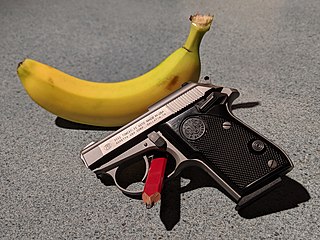
The Beretta 3032 Tomcat and Beretta 3032 Tomcat Inox are semi-automatic pocket pistols designed and manufactured by Beretta. They are chambered in .32 ACP and are small pistols, designed for concealed-carry and use as backup weapons. The Beretta 3032 Tomcat builds on a long line of small and compact pocket pistols for self defense manufactured by Beretta. The allure and popularity is commonly attributed to the loading procedure, which does not require the user to "rack" the slide to chamber a round, but rather place a round in the tip-up barrel before the magazine is inserted. This is especially popular for those with weaker or smaller hands.

The SIG Sauer P226 is a full-sized service pistol made by SIG Sauer. This model is available in four chamberings: the 9×19mm Parabellum, .40 S&W, .357 SIG, or .22 Long Rifle. It has the same mechanism of operation as the SIG Sauer P220, but is developed to use higher capacity, double stack magazines in place of the single stack magazines of the P220.
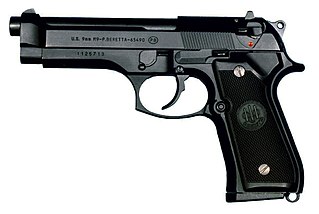
The Beretta M9, officially the Pistol, Semiautomatic, 9mm, M9, is the designation for the Beretta 92FS semi-automatic pistol used by the United States Armed Forces. The M9 was adopted by the United States military as their service pistol in 1985.

The Beretta Px4 Storm is a semi-automatic pistol intended for personal defense and law enforcement use. It is available in full size, Compact, and Subcompact versions. The Px4 uses a trigger and safety system similar to the Beretta 92 and the Beretta 8000 series, though it is distinguished from its predecessors by its light-weight polymer construction with steel inserts, standard Picatinny rail, and swappable grip backstraps. The full size and Compact versions use the same short-recoil, rotating barrel action as the Beretta 8000 series, whereas the Subcompact uses the tilt barrel system.
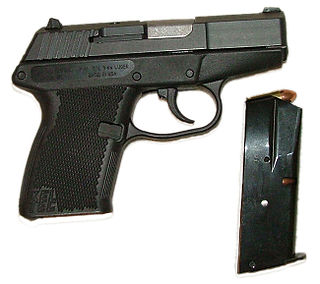
The Kel-Tec P-11 is a compact, semi-automatic, short-recoil operated pistol chambered in 9 mm Luger. It was manufactured by Kel-Tec CNC Industries of Cocoa, FL from 1995 to 2019.

In American English, a pocket pistol is any small, pocket-sized semi-automatic pistol, and is suitable for concealed carry in a pocket or similar space.

Kahr Arms is an American small arms manufacturer focused on compact and mid-size semi-automatic pistols chambered for popular cartridges, including .380 ACP, 9mm Luger, .40 S&W and .45 ACP. Kahr pistols feature polymer or stainless steel frames, single-stack magazines, and double-action-only striker firing actions. Kahr Arms is part of the Kahr Firearms Group, a US-based firearms manufacturer, which also includes Thompson Auto-Ordnance and Magnum Research. The Kahr Firearms Group company headquarters is in Greeley, Pennsylvania, with a manufacturing facility in Worcester, Massachusetts.

A handgun is a firearm designed to be usable with only one hand. It is distinguished from a long gun which needs to be held by both hands and braced against the shoulder. Handguns have shorter effective ranges compared to long guns, and are much harder to shoot accurately. While most early handguns are single-shot pistols, the two most common types of handguns used in modern times are revolvers and semi-automatic pistols, although other handguns such as derringers and machine pistols also see infrequent usage.
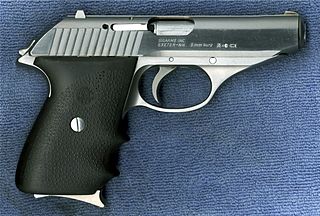
The SIG Sauer P230 is a small, semi-automatic handgun chambered in .32 ACP or .380 Auto. It was designed by SIG Sauer of Eckernförde, Germany. It was imported into the United States by SIGARMS in 1985. In 1996 it was replaced by the model P232.
The Taurus PT1911 is a replication of the US military model 1911 single-action recoil operated semi-automatic pistol. Designed in Porto Alegre Brazil it was initially distributed and released in US consumer market in the fall of 2005.
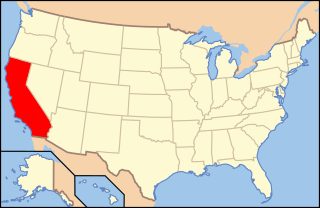
Gun laws in California regulate the sale, possession, and use of firearms and ammunition in the state of California in the United States.
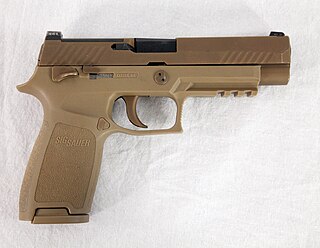
The XM17 Modular Handgun System (MHS) competition was a United States Army and United States Air Force competition for a new service pistol. The Modular Handgun System was solicited by a Request for Proposals in September 2015 and is anticipated to be the next U.S. military standard side arm replacing the Beretta M9 and the SIG Sauer M11. The U.S. Marine Corps also participated in the program to have input on source selection, but likely will not order the resulting weapon until their current pistols' life-cycles end in the mid-2020s.
The Beretta Pico is a small, semi-automatic pistol intended for concealed carry. It’s been discontinued by Beretta.
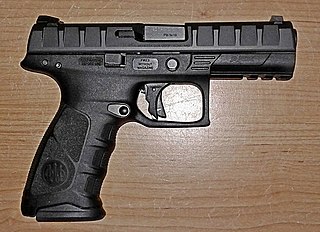
The Beretta APX is a family of polymer-framed, modular, striker-fired semi-automatic pistols designed and produced by Beretta. The series began in 2016, starting with the full-size standard model. The line includes compact, concealed carry, and competition models.

The SIG Sauer M17 and M18 are service pistols derived from the SIG Sauer P320 in use with the United States Armed Forces. On January 19, 2017, the United States Army announced that a customized version of SIG Sauer's P320 had won the Army's XM17 Modular Handgun System competition. The full-sized model was designated the M17, and the shorter length carry model, the M18. The guns have subsequently been adopted by the Army, Navy, Marine Corps, Air Force, and Space Force. The pistol replaces the Beretta M9, as well as several other handguns across the services. There are two color variants, coyote brown and black, for both the M17 and M18, though almost all have been produced in brown.

The Walther PDP is a 9×19mm Parabellum semi-automatic pistol designed in 2021 by Walther Arms as a replacement for the Walther PPQ. The PDP has been designed to be more modular than previous Walther handguns, and has been described by Walther as their flagship handgun.



















